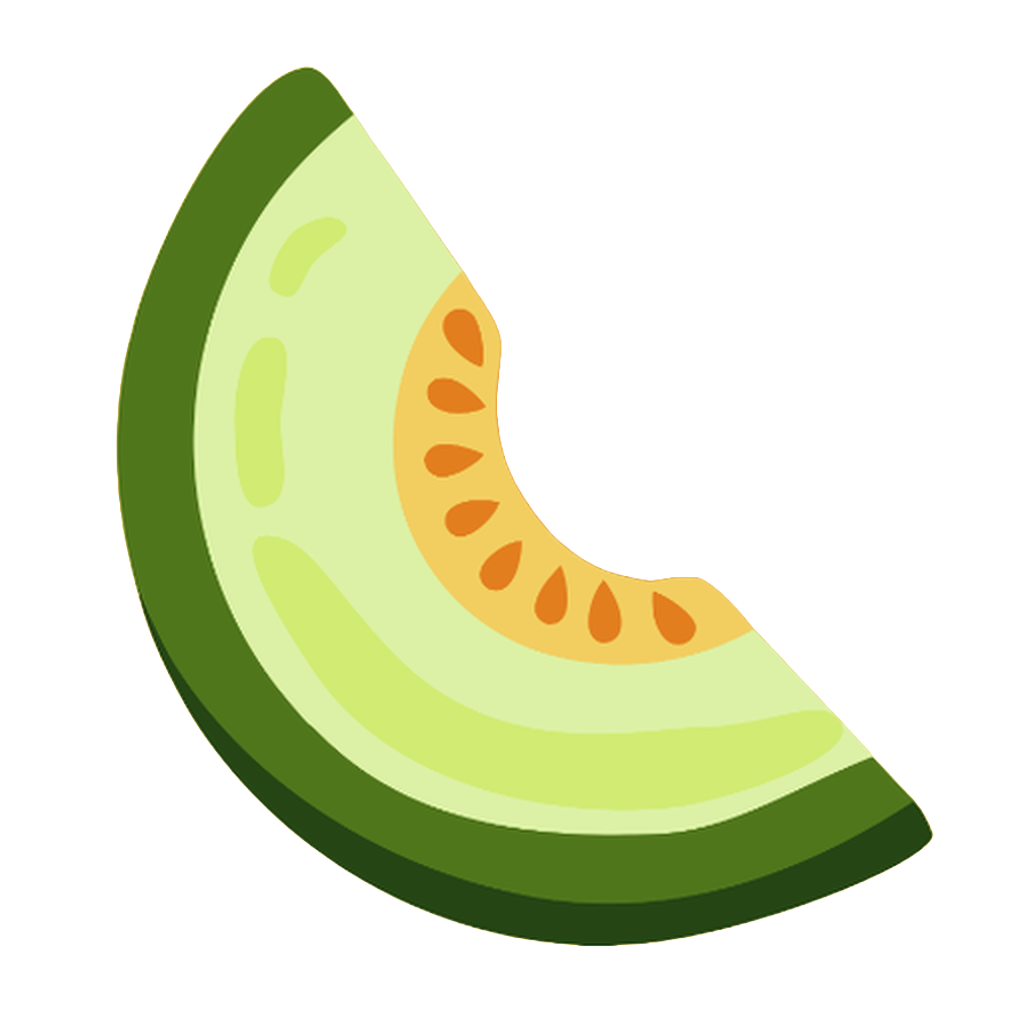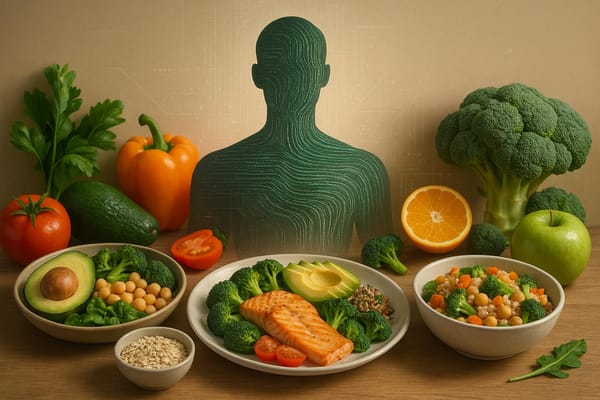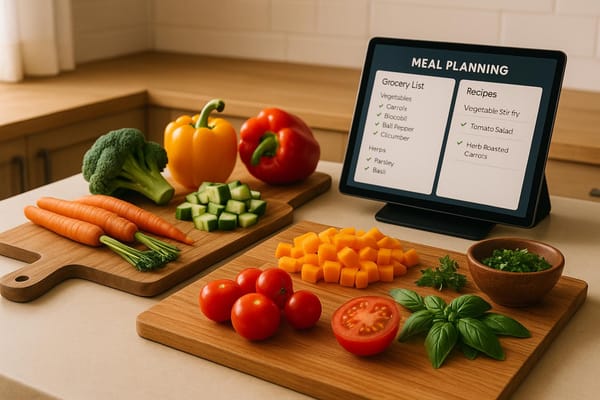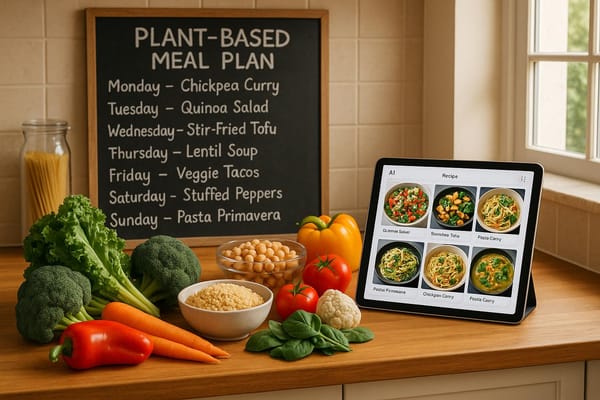Nutrition Tracking: Common Questions Answered
Learn how nutrition tracking can enhance your dietary habits, support health goals, and simplify meal planning with practical tips and technology.
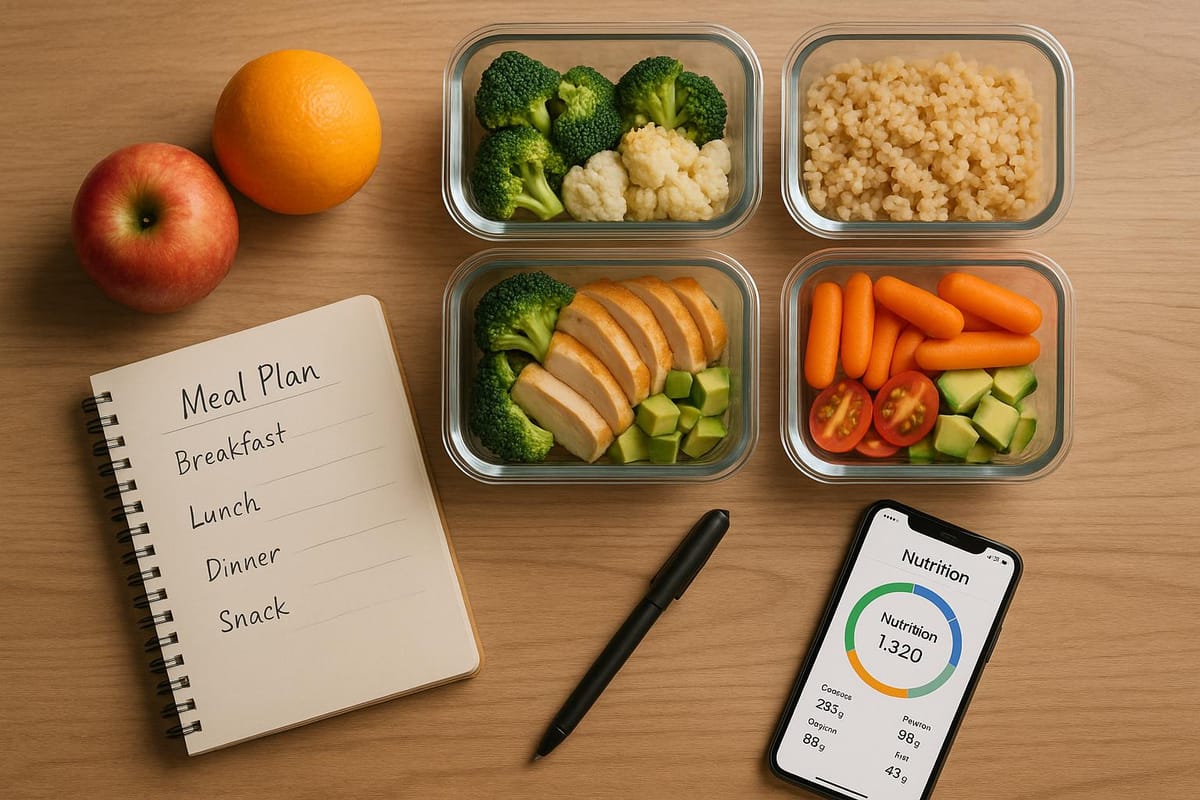
Nutrition tracking is about recording what you eat and drink to better understand your diet and make healthier choices. It helps you monitor calories, macronutrients, and micronutrients, while also identifying patterns in your eating habits. This can support goals like weight management, improving energy levels, or addressing health conditions like diabetes.
Key Takeaways:
- Why track nutrition? It builds awareness, helps achieve health goals, and simplifies meal planning.
- Common challenges: Inaccurate portion sizes, forgetting to log meals, and inconsistent tracking.
- Solutions: Use tools like kitchen scales, log meals immediately, and focus on trends over perfection.
- Tech tools: Apps like Honeydew Recipe Manager streamline tracking with features like AI meal planning, smart grocery lists, and family-sharing options.
Nutrition tracking isn’t about perfection - it’s about building better habits over time. Small, consistent efforts can lead to big improvements in your health and well-being.
How to Track Calories for Beginners
Benefits of Nutrition Tracking
Nutrition tracking goes beyond simply counting calories - it’s a tool that transforms how you approach food and health decisions. By using it, you can make smarter choices, plan meals more effectively, and align your eating habits with your personal goals.
Better Understanding of Food Choices
Tracking your nutrition provides a clear picture of your eating habits, often revealing patterns you might not have noticed. For instance, many people realize they’re consuming more processed foods than they thought or not getting enough protein throughout the day. This awareness is the first step toward healthier decisions.
It also helps you spot nutritional gaps. For example, you might discover you’re consistently low on fiber, consuming too much sodium, or missing essential vitamins. Perhaps you notice your energy dips in the afternoon are tied to skipping breakfast or eating a carb-heavy lunch. These insights allow you to tweak your diet for better balance.
Portion sizes can also be an eye-opener. What you assume is one serving of pasta might actually be three. Nutrition tracking helps you understand portion control and make more accurate choices.
Additionally, tracking sheds light on the timing of your meals. You might find that late-night snacking is hindering your progress or that starting your day with a protein-rich breakfast leaves you feeling more energized. Armed with this information, you can adjust your habits to better suit your needs.
Support for Personal Health Goals
By understanding your food choices, you can align your eating habits with specific health objectives. Nutrition tracking provides concrete data, eliminating the guesswork in achieving goals like building muscle, managing weight, or addressing health conditions.
For those focused on weight management, tracking fosters accountability. It helps you see which eating patterns drive progress and which ones hold you back, making it easier to stay on track.
If you’re managing conditions like diabetes or high blood pressure, tracking becomes even more valuable. Monitoring nutrients like carbohydrates or sodium is simpler when you have detailed records, allowing you to make adjustments before small issues escalate.
Athletes also benefit from tracking their nutrition. It allows for fine-tuning pre- and post-workout meals, hydration strategies, and overall fueling to support performance and recovery. Whether you’re experimenting with different meal timings or nutrient combinations, tracking helps you find what works best for your training.
Beyond the physical benefits, there’s a psychological boost too. Seeing progress - like consistently eating more vegetables or cutting back on sugar - builds confidence and motivation. These small wins can make a big difference over time.
Improved Meal Planning and Efficiency
With a clear understanding of your dietary needs, meal planning becomes more streamlined and effective. Knowing which nutrients you need and where to get them allows you to plan meals with purpose.
Nutrition tracking simplifies grocery shopping by helping you create focused lists. You’ll avoid unnecessary purchases, save money, and reduce food waste. Platforms like Honeydew Recipe Manager take it a step further with AI-powered tools that suggest recipes tailored to your nutritional goals, preferences, and dietary restrictions. This takes the guesswork out of meal planning and ensures your meals align with your health objectives.
Batch cooking and meal prep also become more efficient. By understanding the nutritional profile of your meals, you can plan combinations that provide balanced nutrition throughout the week. Instead of hoping your meals add up to a healthy diet, you’ll know they do.
For families, tracking ensures everyone’s needs are met without the hassle of cooking separate meals. You can plan recipes that work for all age groups, keeping meal prep manageable. Honeydew Recipe Manager even offers features to scale recipes and adjust nutritional calculations for different family members, making family meal planning simpler.
Over time, you’ll build a database of go-to meals that meet your goals, saving you even more time. Instead of constantly researching what to eat, you’ll spend more time enjoying nutritious meals that support your health and lifestyle.
Common Nutrition Tracking Problems and Solutions
Nutrition tracking can be incredibly helpful, but it’s not without its challenges. Many people face obstacles that can derail their efforts, yet with the right strategies, these hurdles can be managed, turning short-lived attempts into lasting habits.
Common Nutrition Tracking Problems
One of the most frequent issues is inaccurate portion sizes. Many people rely on guesswork instead of measuring, which often leads to underestimating how much they’re eating. For example, a "small handful" of nuts might seem like an ounce, but it could weigh significantly more, adding unexpected calories. Even small amounts of calorie-dense items, like cooking oils or salad dressings, can throw off totals if not measured properly.
Another problem is forgetting to log meals. It’s easy to overlook small details like condiments, a splash of cream in coffee, or a quick snack if you don’t log your food right away. These hidden calories can add up over time, affecting the accuracy of your tracking.
Inconsistent tracking patterns are another common pitfall. Many people log their food diligently during the week but skip tracking on weekends or during social events. This inconsistency creates an incomplete picture of their actual eating habits.
Understanding these challenges is the first step toward overcoming them.
How to Track Nutrition Effectively
Tackling these obstacles requires practical habits that make tracking easier and more accurate.
- Consistency matters more than perfection. It’s better to track most meals regularly than to aim for flawless accuracy on just a few days. Even imperfect data can reveal valuable trends in your eating habits.
- Measure portions accurately. A digital kitchen scale can be a game-changer, ensuring your portion sizes are precise.
- Log food immediately. Keeping your tracking app open while eating or jotting down notes right away helps avoid forgetting ingredients or snacks later.
- Don’t overlook small details. Measure often-missed items like oils and dressings before using them. A small notepad in the kitchen or a quick note in your phone can help you capture those extra bites or tastes.
- Track every day, not just “good” days. Logging consistently, even on weekends or holidays, gives you a clearer picture of your overall habits.
- Focus on trends, not daily perfection. Instead of stressing over hitting exact targets every day, review weekly averages for a more balanced perspective on your nutrition.
Using Technology to Make Tracking Easier
Modern tools can simplify nutrition tracking and reduce the effort required. For example, Honeydew Recipe Manager offers features designed to make tracking more efficient and accurate.
- Smart ingredient recognition automatically calculates nutritional details for recipes, saving you time on manual entries.
- Recipe scaling adjusts nutritional values based on serving sizes. Whether you’re cooking for two or a larger group, the app recalculates everything to keep your records accurate.
- Integrated meal planning and grocery lists help you prepare balanced meals in advance, reducing the temptation of impulsive choices and ensuring your tracking reflects well-thought-out meals.
- Family and group planning features make it easier to manage nutrition for multiple people. The app adjusts portion sizes and nutritional details for everyone’s needs, simplifying meal prep and tracking.
How Honeydew Recipe Manager Supports Nutrition Tracking
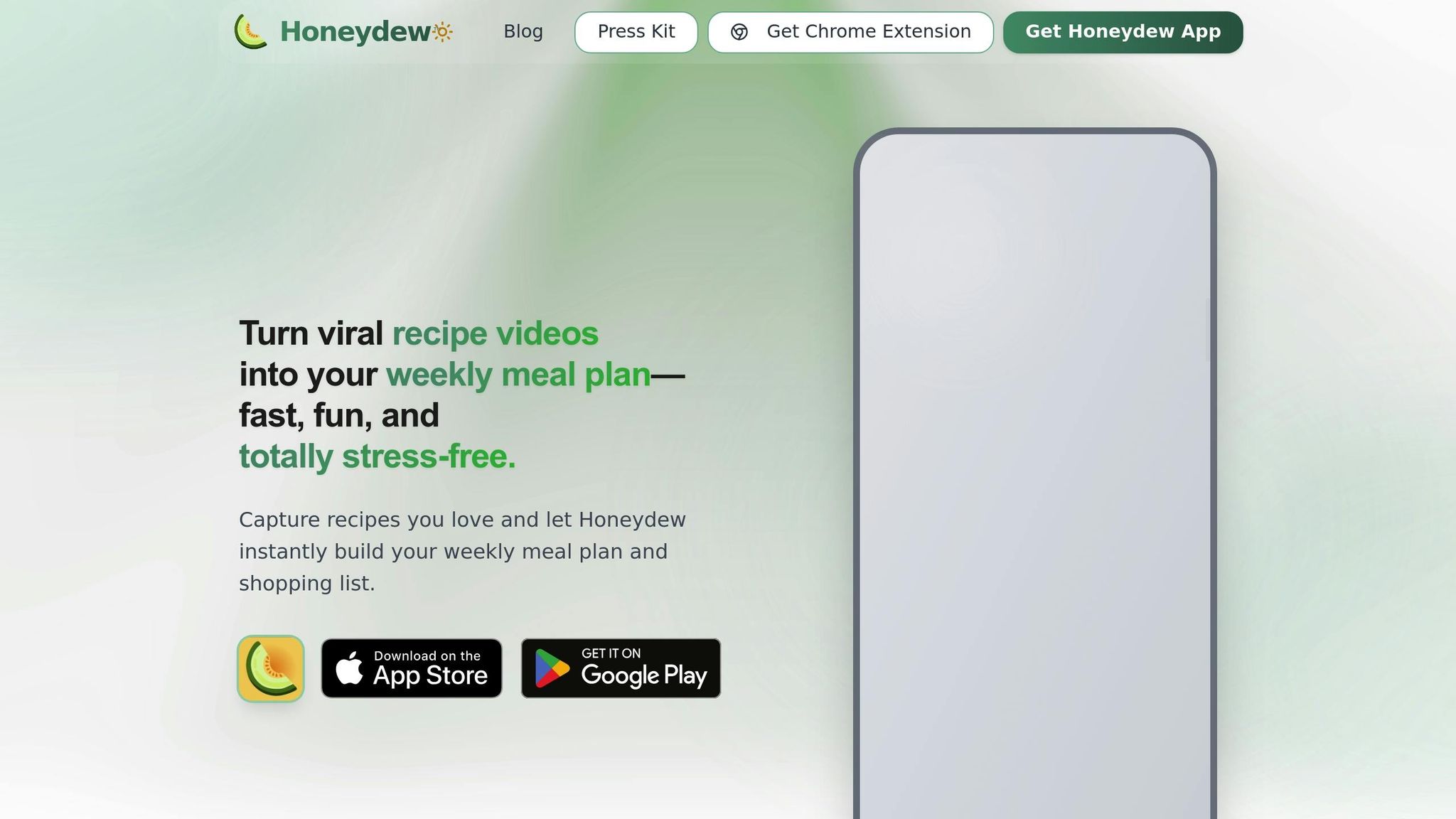
Honeydew Recipe Manager isn’t just a place to store recipes - it’s a tool designed to simplify nutrition tracking and meal planning. By tackling common hurdles in maintaining healthy eating habits, it offers practical features that make staying on track easier. Let’s dive into how Honeydew can help you manage your nutrition goals.
AI-Powered Meal Planning
The app’s AI-driven meal planner creates weekly meal schedules in seconds, saving you the hassle of researching recipes or balancing nutrients. It tailors meal plans to your dietary preferences, whether you’re keto, vegan, paleo, high-protein, or gluten-free.
What’s even better? The AI suggests meals using your saved recipes, so you’re only eating dishes you already enjoy. With the nutritional details baked into the plan, sticking to your goals becomes as easy as following the schedule.
Smart Grocery Lists and Ingredient Management
Honeydew takes the guesswork out of shopping by generating detailed grocery lists based on your meal plans. These lists are organized by store aisle, helping you shop efficiently and avoid impulse buys that could derail your plan. Plus, the one-click Instacart integration makes ordering ingredients a breeze.
If an ingredient is unavailable, the app’s smart substitutions feature (exclusive to Honeydew Plus) suggests alternatives that keep the nutritional profile of your meal intact. This means you won’t have to abandon your plan just because one item is missing.
"The smart grocery lists save me hundreds of dollars a month. I love how it suggests recipes based on what I already have!" - James L., @james_student
"I used to waste so much food. Now with Honeydew's meal planning, I buy exactly what I need and save money!" - Mark T., @mark_cook
Family and Group Planning Features
For households, Honeydew makes nutrition tracking a team effort. Its household sharing feature allows up to six family members to use the app, which is especially helpful when managing different dietary needs. The app automatically adjusts calorie and macro targets for each person, so you don’t have to manually track portions or restrictions.
Meal plans and grocery lists can be synced across family members, keeping everyone on the same page. The AI meal planner even accommodates varying diets within the same household, whether one person prefers high-protein meals and another sticks to plant-based options.
With a 4.8-star rating from 360 users on the Apple App Store and over 50,000 downloads on Google Play, Honeydew Recipe Manager has become a trusted choice for families juggling complex nutrition goals.
Tips for Successful Nutrition Tracking
Tracking your nutrition effectively doesn’t have to be overwhelming. By using simple, sustainable strategies, you can make tracking a natural part of your routine. Not only does this help you log your meals, but it also gives you the tools to improve your meal planning and stay on track with your goals.
Set Realistic and Flexible Goals
Start small and build consistency over time. Begin by logging your meals consistently for a few weeks. This step-by-step approach makes it easier to maintain the habit without feeling overwhelmed by numbers or calculations.
Focus on progress, not perfection. Research shows that regular logging can lead to noticeable improvements over time. The key is staying engaged and consistent rather than trying to achieve 100% accuracy.
Be flexible when life gets busy. Some days - like holidays or hectic work trips - might make detailed tracking tough. On those days, try simpler methods like jotting down portion sizes or snapping a quick photo of your meal. This keeps you connected to your goals without adding unnecessary stress.
Use Technology to Save Time
Leverage smart tools to speed up the process. AI meal scanners can analyze a plate of food in seconds, estimating calories and macros with surprising accuracy. Barcode scanners make logging packaged foods a breeze, and voice logging is perfect for busy moments when typing isn’t practical.
Double-check AI estimates for homemade meals. While technology has come a long way - 75% of AI-driven nutrition research has been published since 2020 - it’s still a good idea to review automated logs for dishes with multiple ingredients. This ensures your entries align with your actual portions.
Tools like the Honeydew Recipe Manager make tracking even easier. Its AI-powered meal planner creates weekly schedules tailored to your nutritional goals, handling complex calculations in the background so you can focus on enjoying your meals.
Review and Adjust Your Approach Regularly
To keep your tracking aligned with your goals, take time to assess and refine your methods.
Set aside time each week to review your data. Spend 10–15 minutes looking at trends in your energy levels, mood, and how full you feel after meals. Use these insights to tweak your meal planning.
Adjust your tracking style as your goals change. For example, detailed logging might help during a weight loss phase, but a more relaxed approach could work better for maintenance. Find what suits your needs at any given time.
Use your data to fine-tune your meals. Pay attention to how different foods and macro ratios affect your energy and cravings. Over time, this helps you create a meal plan that works best for your body.
Remember, tracking is a tool, not the end goal. Whether you’re logging intensively to reset your habits or using a lighter approach for long-term maintenance, the key is to strengthen your relationship with food while keeping the process simple and stress-free.
Conclusion: The Value of Nutrition Tracking
Nutrition tracking can completely change the way you view and manage your eating habits. By keeping a consistent record of your meals, you uncover patterns in your diet, identify foods that keep you energized, and make choices that align with your health goals. Even a simple tracking routine can lead to noticeable improvements in your well-being.
The secret to effective nutrition tracking is finding a method that works for your daily life. Whether you're diligently tracking every macro or taking a more casual approach, sticking with it is more important than making it overly complicated. And with the help of smart tools, the process becomes much easier to maintain.
Take Honeydew Recipe Manager as an example. This app uses AI to create weekly meal plans tailored to your nutritional needs. It calculates calories and macros automatically and even includes family-sharing features to align everyone’s goals effortlessly.
From better meal prep to personalized insights, nutrition tracking gives you the tools to make informed dietary decisions. It’s a way to build a healthier relationship with food without adding unnecessary stress. By setting achievable goals, using technology to simplify the process, and regularly evaluating your progress, you can develop habits that last. Over time, tracking helps you understand portion sizes, recognize when you’re truly hungry, and pinpoint the foods that make you feel your best - knowledge that can guide you toward long-term success.
FAQs
How does nutrition tracking help me find and fix gaps in my diet?
Tracking your nutrition helps you understand your eating habits by logging meals and keeping an eye on essential nutrients like vitamins, minerals, and macronutrients. By reviewing this data, you can identify patterns or gaps in your diet and make changes to improve your overall health and balance.
There are plenty of tools that simplify this process. Features like barcode scanners, extensive food databases, and automatic nutrient tracking make it easier to gather insights. With this information, you can make better choices and plan meals that support your health goals.
How can I avoid common issues like forgetting to log meals or misjudging portion sizes when tracking my nutrition?
Sticking to nutrition tracking can feel like a hassle, but a few straightforward tips can make it much easier. Start by setting reminders on your phone or jotting notes in a planner to log your meals right after eating. This way, tracking becomes a natural part of your day. For portion sizes, use simple tricks like visual comparisons - think of a palm-sized portion for protein - or rely on measuring cups for added precision.
Another game-changer? Planning ahead. Dedicate a little time each week to prepping meals and snacks. Not only does this save you time during busy days, but it also ensures you’ve got balanced options within arm’s reach. And remember, you don’t need to track every single detail. Focus on the essentials - like protein, fruits, and veggies - to keep things simple and stay motivated.
How does Honeydew Recipe Manager use AI to make meal planning and nutrition tracking easier for different diets?
Honeydew Recipe Manager uses AI technology to make meal planning and nutrition tracking a breeze. It creates personalized weekly meal plans that fit your dietary needs, preferences, and restrictions. Whether you're into vegetarian dishes, following a keto lifestyle, or need gluten-free options, Honeydew ensures your meals are perfectly aligned with your goals.
The app also features smart ingredient substitutions, letting you make healthier choices or tweak recipes based on what’s already in your kitchen. Even better, you can create recipes from photos or social media posts, making it effortless to try out new ideas. With Honeydew, meal planning becomes stress-free, leaving you more time to enjoy delicious, balanced meals.
